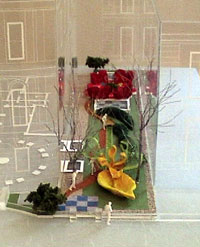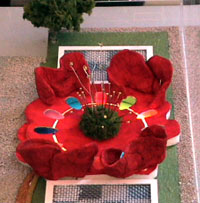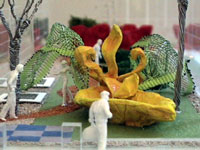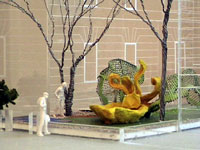LES FLEURS DE FRANCE
| > garden > Competitors: Patricia Johanson/OIKOS | Biography |
| Garden Competition PATRICIA JOHANSON / OIKOS |
|
LES FLEURS DE FRANCE |
|
LES FLEURS DE FRANCE celebrates the history and culture of France through two simple yet archetypal French flowers : "Iris pseudacorus" and "Rosa gallica." These two blooms are united by their elemental design, and elegant recurrence in French art, architecture, history and myth. "Rosa gallica", the rose of Provins, is known as "The French Rose". In the gardens of both Marie-Antoinette and the Empress Josephine, Pierre Joseph Redoute created studies for his exquisite engravings Les Roses, justifiably among the more famous illustrations in the world. Like the rose window in the great cathedrals of France, Redoute's engravings are known for their translucence, showing the light within. |
 |
The twelve petals of "Rosa gallica", like the twelve converging avenues at the Arc de Triomph and of the rose window in the western facade of Chartres, reinforces the power of symmetry in art. By day the rose is a "secret garden". At the center a melange of sculptural stamens recalls the "Marais" at Versailles, with its metal, water-spouting reeds. At night, especially when viewed from the second-floor reception area of the French Cultural Services, a glowing pattern of jewel-like colors suggests the Plate Tracery of Chartres. |
 |
At the front of the garden "Iris pseudoracorus" combines a publically visible water feature with the art of trellis. Petals frame the view, both into the garden, and out to Central Park, conveying a sense of sculptural form and creative engineering. It was the golden reflection of this "Yellow Flag Iris" that reportedly guided Clovis' army across the Rhine. Since that time the little iris adopted by Clovis as his symbol has been transformed into the fleur-de-lys, and has appeared in countless representations, from the Saint Chapelle and the banner Louis VII carried to the Crusades, to the present day. |
 |
In sunlight the iris sometimes reflects a rainbow spectrum, reminding us of the magical and scientific aspects of natural light. It was the scientific investigations of Chevreul that inspired the Impressionist painters. The stem of the iris (axial planning in miniature) merges with the more free-flowing stem of the rose. Water and reflective glass, art and nature become one. At night the sculptured sepals of the "fleur-de-lys" are bathed in golden light, creating a landmark that is easily visible from Fifth Avenue. |
 |
Panels of blue, white, and red lighting, reminiscent of the theatrical spectacles designed for the great French gardens may also suggest the flag of the French Republic. Sensuous and sculptural borders burst out of functional parterres. |
|
|
| art | books | cinema | education | music | people | performing arts | tv/radio |
© Cultural Services of the French Embassy |
|